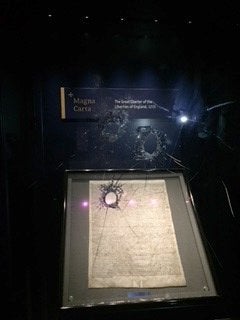Man arrested over 'attempted theft' of Magna Carta from Salisbury Cathedral by ‘smashing glass case with hammer’
No damage done to ancient document
Your support helps us to tell the story
From reproductive rights to climate change to Big Tech, The Independent is on the ground when the story is developing. Whether it's investigating the financials of Elon Musk's pro-Trump PAC or producing our latest documentary, 'The A Word', which shines a light on the American women fighting for reproductive rights, we know how important it is to parse out the facts from the messaging.
At such a critical moment in US history, we need reporters on the ground. Your donation allows us to keep sending journalists to speak to both sides of the story.
The Independent is trusted by Americans across the entire political spectrum. And unlike many other quality news outlets, we choose not to lock Americans out of our reporting and analysis with paywalls. We believe quality journalism should be available to everyone, paid for by those who can afford it.
Your support makes all the difference.A man suspected of using a hammer to steal a copy of Magna Carta from Salisbury Cathedral was wrestled to the ground and held by two employees before his arrest, police said.
The 45-year-old is said to have smashed through an outer layer of protective glass surrounding the priceless 1215 document housed at the cathedral.
The Rev Nicholas Papadopulos praised the “courageous” staff members who he said were able to restrain the man for 12 minutes before authorities got to the scene.
“He walked out of the chapter house and tried to leave the cathedral via our work yard and he was detained there and restrained until the police arrived,” the dean said.
Staff were alerted after an alarm sounded and Wiltshire Police were called on Thursday afternoon at around 5pm.
Witnesses described seeing the two men apprehend the suspect.
Speaking to the Salisbury Journal, Jenny, a witness, said: “We were walking past the cathedral as the alarms started, and everyone was starting to come out.
“As we got to the stonemason’s gateway we heard some shouting and could see a few people coming out of the gates so we stopped.
“It looked like some men play-fighting but as they got through the gates I saw a hammer drop to the floor and one of the men kicked it into the road whilst another man held on to him.
“They then held onto him with hands behind his back whilst they picked up the hammer – lots of people around started to come over
“The men really did a good job.”
The suspect, whose name has not yet been made public, was arrested shortly afterwards on suspicion of attempted theft, possession of an offensive weapon and criminal damage.
Photographs show the man successfully broke through the glass case, but had been unable to reach the document before he was stopped.

No damage was done to the ancient text, which formed the basis of modern justice and human rights, and has been described as the most important document in the world.
A police spokesman said: “A 45-year-old man is in custody this morning arrested on suspicion of attempted theft of Magna Carta.
“Shortly before 5pm yesterday alarms were activated at Salisbury Cathedral after an attempt was made to smash the glass box surrounding the Magna Carta.
“Staff were alerted and police were called.
“A man matching the description given by witnesses was arrested on suspicion of attempted theft, possession of an offensive weapon and criminal damage, and has been taken to Melksham custody for questioning where he remains.
“The Magna Carta has not been damaged and nobody was injured in the incident.
“We are aware there were a number of witnesses to the incident who may not have spoken to police.”
Magna Carta, Latin for “great charter”, was brought into law under King John of Runnymede on 15th June 1215.
It was credited as being one of the first documents to limit the power of the crown.
The charter was imposed upon the king by a group of his subjects, the feudal barons, and limited his powers on the likes of punishing a “freeman”, unless through the law of the land.
But the document didn’t last long, with Pope Innocent III annulling it in August 1215, saying it was a “shameful and demeaning agreement, forced upon the king by violence and fear”.
After King John died, his successor Henry III thought it was a good idea and brought it back.
Three clauses of the 63 are still in force today – freedom of the English church, the ancient liberties of the City of London and a right to due process.
It was written in Latin by hand, by an expert scribe, on parchment.
Magna Carta was not signed, but sealed, and at the bottom of the Salisbury copy it is possible to see the marks where King John’s seal was once attached.
Shortly after the originals were sealed, at least 13 copies were made but there are just four remaining copies of Magna Carta. Two are kept in the British Library, one is in Lincoln Cathedral and one at Salisbury Cathedral, which is the best-preserved manuscript.
PA contributed to this report
